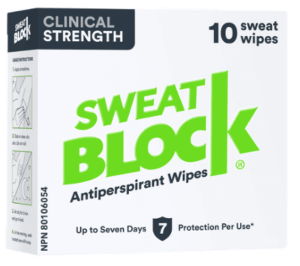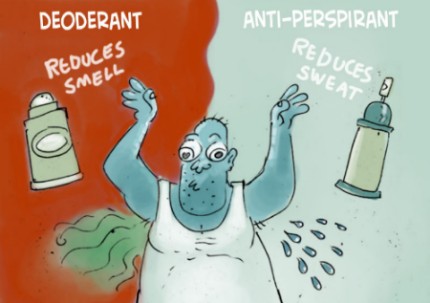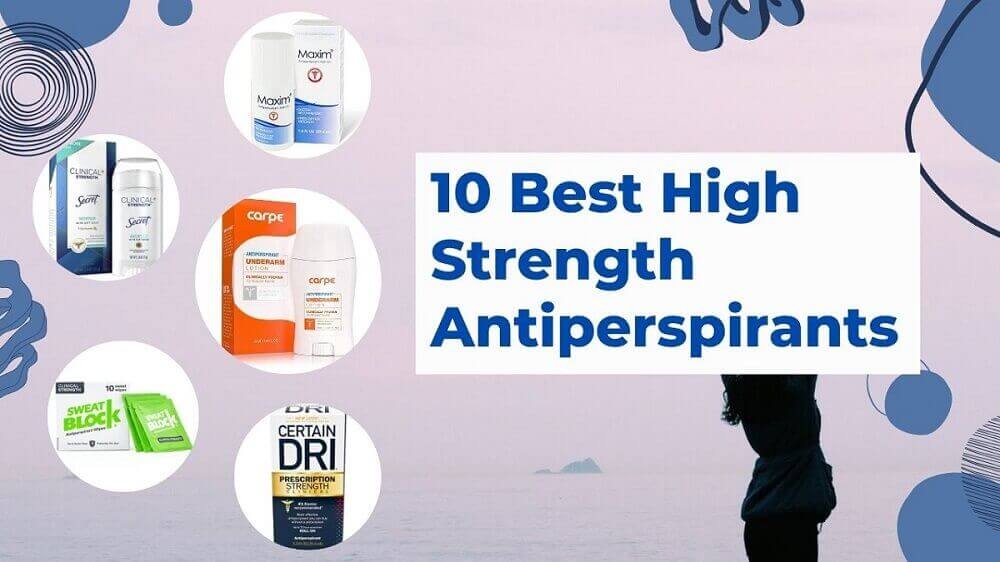
On this page, you will learn everything you ever wanted to know about dermatologist recommended high strength antiperspirants. For both men and women with sweaty armpits. Note that to prevent underarm odor, some of these products may be formulated to also include a deodorant. Make sure to also read my detailed page on armpit sweating solutions.
I will give you my recommendations of the 10 best clinical strength antiperspirants that work great in reducing excessive sweating (hyperhidrosis). A very popular newer alternatives to treat excessive underarm sweating is miraDry, which has the added benefit of also reducing underarm hair quantity. Make sure to also check out my Botox treatment for excessive sweating.
Let's jump right in:
Pros: Very cheap at around $5 per pack (with each pack = 35 ml). Many favorable reviews on Amazon (average rating of 4.6/5 stars) and Walmart. Also make sure to read about my Certain Dri experiences to reduce underarm sweating.
Cons: Potential itching and irritation due to the use of aluminum chloride. 12 percent aluminum chloride is not very strong. Perhaps still worth testing out prior to getting higher aluminum content products.
Pros: 20 percent aluminum chloride is quite strong in an antiperspirant. The company adds no water to the product; Micro dosed pump prevents over-application of product and enables product to last for a long time; Many favorable reviews on Amazon and on the company's own website. 40 years of market presence and product innovation.
Cons: Potential itching and skin irritation due to the use of aluminum chloride. Moderately expensive for a 30 ml antiperspirant spray or aerosol.
Pros: A newer high-strength 25 percent aluminum sesquichlorohydrate product that can stop sweating with long-lasting results. Fairly cheap at around $9 per 50 ml.
Cons: Such a high strength aluminum content product should not be used every day per some dermatologists. Some users may also get allergic reactions.
Pros: Reasonably priced at $14 for 30 ml. Includes antiperspirant as well as deodorant. Average rating of 4.3/5 stars on Amazon.
Cons: 15 percent aluminum chloride is not as strong as some would prefer.
Pros: Smooth, non-greasy, and non-irritating clinical strength antiperspirant lotion. Includes natural eucalyptus oil and moisturizing ingredients that gently soothe the skin. Has quick-drying properties. Good price.
Cons: 15 percent aluminum sesquichlorohydrate makes this product weaker than the Mitchum product I list further below.
Pros: Prescription strength at 20 percent aluminum zirconium tetrachlorohydrex Gly. A decent 4.2/5 stars in average rating on Amazon.
Cons: Some complaints about itching and burning on sensitive skin.
Pros: Clear gel product that is preferred by some. Extremely high-strength 25 percent aluminum sesquichlorohydrate. Excellent price. Mitchum clinical gel provides 48-hour protection against wetness and odor. A stellar 4.8 out of 5 stars average rating on Amazon (across almost 1,900 customer reviews at the time of writing).
Cons: Such a high strength aluminum content product should probably not be used every day.
Pros: Unique ingredient of 20 percent aluminum zirconium tetrachlorohydrex, which is very strong. Respected personal care brand.
Cons: Some complaints about residue stains and packaging issues.
Pros: Bestselling product with huge number of reviews on Amazon.
Cons: 14 percent aluminum chloride is not as strong as some would prefer, but close to the highest dose of aluminum chloride allowed by the US FDA.
Pros: Yet another high-strength 20 percent aluminum zirconium tetrachlorohydrex product.
Cons: Relatively newer product with fewer reviews in comparison to some of the more established clinical strength antiperspirants out there.

Degree Antiperspirant Deodorant -- Solid
Pros: Aluminum zirconium tetrachlorohydrex GLY 20%. Respected brand.
Cons: Some complaints about the stick leaving residue stain and chunks. Pricey for its size.
Old Spice Extra Fresh -- Solid
Pros: Aluminum zirconium trichlorohydrex Gly 19% (anhydrous). Respected brand.
Cons: Some people do not like this product's scent.
AHC30 Forte -- Liquid
Pros: A crazy high 30 percent aluminum hexachloride.
Cons: Prescription strength. Seems to only be sold directly in parts of Western Europe. I am uncertain about the long-term side effects of daily applications of 30 percent aluminum hexachloride.
Drysol -- Liquid
Pros: Reasonably priced at around $20 for 37.5 ml. 20 percent aluminum chloride hexahydrate = quite strong.
Cons: Potential itching and irritation due to the use of aluminum chloride. No reviews on Amazon.
Driclor 75 ml -- Roll-On
Pros: Very cheap at $20 for 75 ml. 20 percent aluminum chloride hexahydrate is quite strong.
Cons: Potential itching and rash due to the use of aluminum chloride.
Perspirex -- Roll-On
Pros: Comes in Comfort, Original and Strong versions. The Original has 15% Aluminum Chloride Hexahydrate. Over 2,000 reviews, currently averaging a rating of 4.4 out of 5 stars.
Cons: Costs $20 for 20 ml, which is a bit pricey.
ZeroSweat Antiperspirant Deodorant -- Rolll-On
Pros: Aluminum chloride solution 15% is just strong enough to ensure sweat cessation without any side effects. 4.3 out of 5 stars average rating on Amazon.
Cons: Some complaints about the roller ball not working great and underarm skin burning.
To counter excessive armpit odor, some people prefer to use prescription strength deodorants. The armpits contain apocrine glands (which smell, unlike eccrine glands) due to the presence of axillary region hair follicles. In addition to the desired fragrance or scent, most of the best deodorant sprays and sticks also come with a mild antiperspirant (usually aluminium based). This antiperspirant deodorant combination is perfect for use after going to the gym or prior to stressful events such as public speaking. Among the most popular extra strength deodorants on the market include:
Some of these products such as Tom's of Maine and Native contain natural ingredients without any aluminum or chemicals such as parabens and phthalates. Native deodorant contains baking soda (sodium bicarbonate) for sweat reduction and moisture absorption. It also includes eucalyptus, mint, coconut oil, shea butter, probiotics and tapioca starch. Another natural product called Crystal mineral deodorant stick contains only mineral salt. It leaves no white marks and does not block your pores.
For localized hyperhidrosis problems, the first treatment of choice is strong (or clinical strength) antiperspirants. How often should you use antiperspirants? Most people do so on a daily basis, since the underarms perspire so frequently. Some people even use separate products in the morning and at night (often labeled AM/PM). Low strength basic anti-perspirants and deodorants from renowned brands such as Dove, Secret and Gillette are ineffective in reducing excessive perspiration too much. Stronger clinical strength products can prove to me more effective, especially in the armpit region.
There are dozens of well known top rated clinical strength antiperspirant products out there, and some require a prescription. This is due to their high aluminum content and an alcohol rather than water base. The few extra strength products that I have tried using to relieve my excessive feet sweating proved to be ineffective. However, I have seen good results on my armpit sweating where the skin is much thinner than in the feet.
Some people have success using antiperspirants on their face and hands too, but generally speaking, iontophoresis machines have a much higher rate of success in those areas. The hands and feet contain a majority of the body's sweat glands and also have very thick skin, making antiperspirant absorption difficult. Nevertheless, anti-perspirants are so much cheaper than other hyperhidrosis treatments, that it makes sense to always try them as a first treatment of choice.
Note that I did not try applying antiperspirants on my feet in the most effective way per some people -- i.e., before going to bed at night, wash your sweaty feet (or hands or face); towel dry the wet skin thoroughly; apply the strongest antiperspirant you can tolerate; cover the feet (or hands or face) in saran wrap; go to sleep; and then repeat the process the next night. Besides not wanting to participate in such a tedious process every day, my feet don't sweat at night when I am asleep and my hyperactive sympathetic nervous system is relaxed.
Antiperspirants work by blocking the sweat ducks underneath your armpits. These are located near the opening of the epidermis top layer of the skin in the underarms. This significantly reduces the amount of sweat that can reach the skin surface and cause wetness. Typically, you will need to reapply the antiperspirant once per day. Some people recommend shaving your armpits regularly to improve hygiene and ensure that pores are not inflected or clogged. A bare armpit will also absorb the antiperspirant better.
The active ingredient in most strong antiperspirants consists of aluminium salts (specifically, aluminium chloride or aluminium chlorohydrate). The aluminum ions modify the pH balance in the axillary region.
There are two types of sweat glands in the human body: apocrine and eccrine. The underarm and genital regions are the only part of the body which contains both apocrine and eccrine glands. The former is responsible for foul body odor and embarrassing stinky pits. The latter causes perspiration without any strong odors. Some natural products such as baking soda can help reduce excessive underarm sweating, but not entirely.
People confuse antiperspirants with deodorants all the time. However, the two are quite different and its time for a definition of each. The main function of anti-perspirants is to reduce excessive sweating significantly. This is accomplished by a chemical compound ingredient forming a plug around the sweat glands and reducing or eliminating the flow of moisture. In effect, clinical strength antiperspirants are considered as a drug, sometimes even requiring a prescription. Antiperspirant sticks often incorporate an astringent. Most antiperspirants are unscented and have no odour.
On the other hand, scented deodorants are mainly used by both men and women to reduce unpleasant armpit odor (bromhidrosis), and are thus classified as cosmetics. This is accomplished by the key ingredient in the deodorant (e.g., triclosan) killing bacteria and fungus that causes the bad smell. Some of these antimicrobial antiseptic ingredients are used in combination with alcohol, parabens, propylene glycol, steareth-20, triethanolamine and diethanolamine. These can cause side effects such as dryness, irritation and breakouts in those with sensitive skin. Some of those ingredients can also be toxic and carcinogenic in animals the long run, although there is some debate about this when it comes to humans. Note that a deodorant is different from perfume or cologne.
Nowadays, there are many organic "green" natural deodorant and natural antiperspirant products available for purchase. These will include herbal ingredients such as lavender. Note that many two-in-one combination antiperspirant deodorant products include both antiperspirant and deodorant ingredients with fragrance to reduce smelling. However, most people seem to prefer buying each product separately.

The vast majority of antiperspirants contain some kind of aluminum based compound as the main active ingredient. Historically, aluminum chloride and aluminum chlorohydrate were the active ingredients of choice. However, both these products can cause irritation to the skin. Newer generation antiperspirants contain aluminium zirconium compounds, with aluminum zirconium tetrachlorohydrex glycine recently becoming a popular option. Another variety called aluminum bromohydrate (also known as aluminum hydroxybromide) is also used in some products. The US FDA allows over-the-counter antiperspirants to consist of between 15 and 25 percent aluminum (with the figure varying based on the specific compound being used). Some products will include moisturizer and antibacterial ingredients.
Aluminum based compounds are the main active ingredient in virtually all high strength antiperspirants. These compounds temporarily plug sweat ducts, in the process stopping the flow of sweat to the skin's surface. In recent years, fears have been raised that frequent application of aluminum based antiperspirants on the skin near the breast may lead to significant absorption by the body and result in estrogen like hormonal changes. Since estrogen has the ability to promote the growth of breast cancer cells, some researchers have warned that frequent use of aluminum based products with toxins could potentially lead to the development of breast cancer.
However, there are no consistent and large-scale research findings on this issue regarding a positive correlation between antiperspirant use and development of breast cancer. I feel that these fears are overblown, and the American Cancer Society seems to agree. Fact checking website Snopes also concludes that anti-perspirants do not cause breast cancer.
If you are overly concerned about the potential of side effects from using aluminum based anti-perspirants, I would suggest reducing the frequency (and strength) of each application. Or trying alternative treatments such as miraDry and laser sweat ablation. Note that similar fears have arisen when it comes to deodorants and antiperspirants causing Alzheimer's disease. Something that has also not been proven conclusively.
As of 2023, the U.S. Food and Drug Administration (FDA) has approved 18 different types of aluminum salts for use as active ingredients in over-the-counter (OTC) antiperspirants. The list of these is as follows:
(a) Aluminum chloride up to 15 percent, calculated on the hexahydrate form, in an aqueous solution nonaerosol dosage form.
(b) Aluminum chlorohydrate up to 25 percent.
(c) Aluminum chlorohydrex polyethylene glycol up to 25 percent.
(d) Aluminum chlorohydrex propylene glycol up to 25 percent.
(e) Aluminum dichlorohydrate up to 25 percent.
(f) Aluminum dichlorohydrex polyethylene glycol up to 25 percent.
(g) Aluminum dichlorohydrex propylene glycol up to 25 percent.
(h) Aluminum sesquichlorohydrate up to 25 percent.
(i) Aluminum sesquichlorohydrex polyethylene glycol up to 25 percent.
(j) Aluminum sesquichlorohydrex propylene glycol up to 25 percent.
(k) Aluminum zirconium octachlorohydrate up to 20 percent.
(l) Aluminum zirconium octachlorohydrex gly up to 20 percent.
(m) Aluminum zirconium pentachlorohydrate up to 20 percent.
(n) Aluminum zirconium pentachlorohydrex gly up to 20 percent.
(o) Aluminum zirconium tetrachlorohydrate up to 20 percent.
(p) Aluminum zirconium tetrachlorohydrex gly up to 20 percent.
(q) Aluminum zirconium trichlorohydrate up to 20 percent.
(r) Aluminum zirconium trichlorohydrex gly up to 20 percent.
See my experiences with Dehydral for more.
No official website for product, and hard to find elsewhere it seems.
